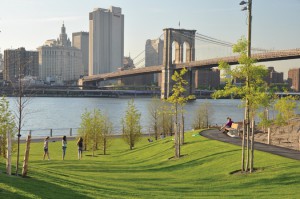My location for Project #2 is the Brooklyn Bridge Park. To get to this magical place, I took a left onto Jay St. upon exiting Namm Hall. After getting to the end of the block that our college is located on, I ran into Tillary St. While waiting for the crosswalk light to change, I noticed a park caddy corner from where I was standing. This park seemed to always be in use. Whether it was one person doing pull-ups on the monkey bars or a group of 15 kids playing a game of basketball all at once. This makes sense considering all the academic locations nearby. Intermediate and college alike. As I continued further, I passed many more college campus locations. Some for City Tech. There was a church on my right that always seems to be filled with light, literally and figuratively. This seems hard to find nowadays. Maybe it’s because I am not around at the right times, but this church seemed to be very lively with loud choir music; clapping; and honestly, pure joy. I am not the most religious person, but this is something that could sway me to be a born-again christian. As I trudge along a street that now seems to be dying down a little considering that is where the bridge lets out and there isn’t much room for industrialization of any kind; I think to myself how twisted and tangled the roads are because of all the outlets, entries, and one-ways. Thinking historically, I would say that this very same area at one point had probably just one road that was two-ways and one entrance/exit to the bridge. This is speculation of course. When i finally get past this mess of intersections and lack of cross-walks I am happy to have survived. This makes the rest of my trip that much more fulfilling. I had just gone under the Brooklyn Bridge, but there seems to be another overpass just before the York St. subway station. It looks ordinary looking directly at it but as you pass through, on either side it says “Yes.” Very artistically written and it seems to be a juxtaposition of emotions, because one side is very colorful and full of life, while the other is plain and black and white. Still they relay the same text, maybe just different messages. This reminds me of a quote from “Fort Greene Dreams”, by Nelson George that reads, “The New York Times was among the many publications that profiled the area, making Fort Greene synonymous with a “Brooklyn Boheme” vibe.” When i see art like this in the most unlikely places, it makes me remember how artistic Brooklyn is. Even though many can take it for granted, it is still noticed by even the most prestigious of magazines. I take this thought with me as i continue down Jay St. Once I pass through York, I notice a huge contrast between the street itself and the store fronts. This is a perfect example of a juxtaposition. Everything lining the street seems to be brand new. From the grocery store to the high-rise apartments. The street itself though, is very old. Laid with brick and very unsteady, even to walk on, it still has the old railroad tracks imbedded. I am especially aware of this fact because I do deliveries in my car through that area and I can almost feel the shocks in my car giving out due to the turbulence. Eventually, I reach the water and cannot continue further. I decide to go left knowing that to the right is project housing and the Brooklyn Navy Yard which I am already familiar with. When I make that left onto John St., there are big warehouses and what looks to be empty spaces even though that is hard to believe considering the popularity of the area. I happen to know that a lot of the seemingly unoccupied buildings have some office space or even large apartments because I deliver pizza to them. This is quite the juxtaposition. As I walk past a large glass enclosure with a brand new carousel inside, I can see the park on the horizon. It is very beautiful. Green and bright with a playground for children and usually many activities and fundraisers going on. In my eyes, this is the ultimate juxtaposition because of all the brand new landmarks being over-shadowed by arguably the most historical monument in Brooklyn. In the essay “City Limits” by Colson Whitehead, he says, “Go back to your old hauntings in your old neighborhoods and what do you find: they remain and have disappeared.” Looking up at the bridge from the stand-point of the park, I wonder if a man who had grown up in the area and returned many years later would recognize the space the park takes up. He may say to himself that nothing looks the same and it is a brand new landscape from the one he remembers from his childhood. He may even look across the water and think that the New York City skyline looks very different, but all he has to do to see a familiar site is to look up. The Brooklyn Bridge hasn’t changed for well over 100 years.
Being in Brooklyn
Communicating on the OpenLab





